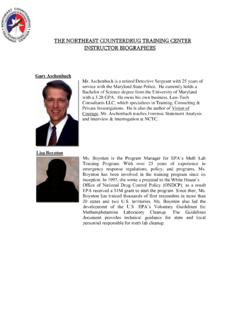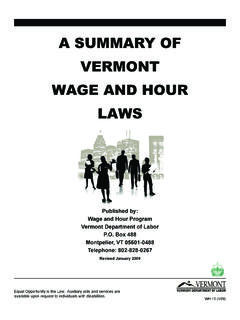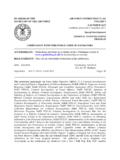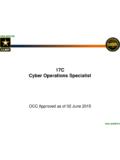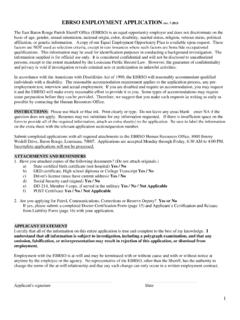Transcription of FIRE AT-WILL MPLOYEE TERMINATIONS IN …
1 {00259668;v2 } fire AT-WILL : EMPLOYEE TERMINATIONS IN PENNSYLVANIA MICHAEL J. TORCHIA, ESQ. Semanoff Ormsby Greenberg & Torchia LLC Huntingdon Valley, Pennsylvania Copyright 2011, Michael J. Torchia, Esquire, Semanoff Ormsby Greenberg & Torchia LLC {00259668;v2 } Outline I. AT-WILL basics II. STATUTORY EXCEPTIONS III. CONTRACT EXCEPTIONS A. Express Contracts B. Employee Handbooks C. Additional Consideration Supplied by Employee Handbook D. Specific Intent to Harm E.
2 Implied Covenant of Good Faith and Fair Dealing F. Tortious Interference with AT-WILL Employment IV. PUBLIC POLICY EXCEPTIONS A. Worker s Compensation Act B. Unemployment Compensation Act C. Occupational Safety and Health Act ( OSHA ) D. Jury Duty E. Criminal Background History F. Polygraph Tests G. Pennsylvania Human Relations Act ( PHRC ) H. Wage Payment and Collection Law ( WPCL ) I. Uniform Commercial Driver s License Act ( UCDLA ) J. Illegal Activity K. Work Related Incidents L.
3 Privacy M. Free Speech N. Sovereign Immunity O. Legislative Immunity P. Pennsylvania Worker and Community Right-to-Know Act ( PWCRA ) Q. Victims of Medical Malpractice V. PUBLIC POLICY EXCEPTION FOR CLAIMS OF SEXUAL HARASSMENT IN THE WORKPLACE VI. WHISTLEBLOWING A. The Whistleblower Law Does Not Create A Public Policy Exception B. The Broadening Definition of Employer C. The Fine Line Between Voluntary Action and Obligation D. Is it Whistleblowing or Retaliation? VII. LIFESTYLE DISCRIMINATION: WHERE THERE S SMOKE, YOU RE FIRED!
4 VIII. PRACTICAL TIPS WHEN CONSIDERING A WRONGFUL DISCHARGE CLAIM A. Analysis of Claim B. Litigation Avoidance: The Amicable Separation 1. Employer s reasons to negotiate a separation package 2. Employer s reasons not to negotiate a separation package 3. Employee s reasons for seeking a separation package C. Employee Separation Checklist {00259668;v2 } I. AT-WILL basics The employment AT-WILL doctrine, in its most basic form, provides that an employer may terminate an employee at its will , and an employee may terminate his or her employment at its will with no legal recourse for the non-terminating party.
5 Absent contractual or statutory restriction, either the employer or the employee may terminate the employment relationship for good reason, bad reason, or no reason at all. See Yetter v. Ward Trucking Corp., 585 1022, 1025 (Pa. Super.), allocatur denied, 600 539 (Pa. 1991). As a general rule, an AT-WILL employee has no claim against an employer for termination of employment or wrongful termination . Paul v. Lankenau Hosp., 569 346, 348 (Pa. 1990); Clay v. Advanced Computer Applications, Inc.
6 , 559 917, 918 (Pa. 1989); Geary v. United States Steel Corp., 319 174 (Pa. 1974). Exceptions to this rule have been recognized in only the most limited of circumstances, where discharges of AT-WILL employees would threaten clear mandates of public policy. Clay, 559 at 918. Since then, the Pennsylvania Supreme Court has held fast and stated, As our previous jurisprudence has shown, this Court has steadfastly resisted any attempt to weaken the presumption of AT-WILL employment in this Commonwealth.
7 McLaughlin v. GastroIntestinal Specialists, 750 283, 290 (Pa. 2000). Practice Tip: The odds favor the employer defending a wrongful termination claim. One of the earliest pronouncements of the employment AT-WILL doctrine in Pennsylvania comes from Henry v. Pittsburgh & Lake Erie Co., 21 A. 157 (Pa. 1891) stating that, [an employer] may discharge an employe [sic] with or without cause at pleasure, unless restrained by some contract .. Id. at 157. This statement is true today, although there are exceptions to termination beyond an express contract.
8 Well over a century after Henry, employers are cautious before discharging employees and must keep in mind the common law exceptions to the employment AT-WILL doctrine and the myriad statutory exceptions restricting an employer from unencumbered termination of its employees. Although most every case involving AT-WILL employment assumes there is an employee -- as distinguished from an independent contractor -- there are indications that the body of law applicable to AT-WILL employment is just as relevant to independent contractors.
9 In Fraser v. Nationwide Mut. Ins. Co., 352 107 (3d Cir. 2003), Fraser was an independent contractor for Nationwide authorized to sell insurance on an exclusive basis under an agent s agreement. Id. at 109. Fraser claimed he was terminated for filing complaints with the Pennsylvania Attorney General s office regarding alleged illegal conduct of Nationwide. Id. Nationwide countered that Fraser was terminated because he was disloyal by offering Nationwide s customers to competitors.
10 Id. Fraser claimed wrongful termination . Nationwide succeeded on summary judgment, and the Third Circuit affirmed the dismissal of the wrongful discharge claim stating Fraser s termination did not fall within any recognized public policy exception to the AT-WILL employment doctrine. Id. at 113. In doing so, the Third Circuit rejected Nationwide s argument that public policy exceptions did not apply because he was an independent contractor, not an employee.


